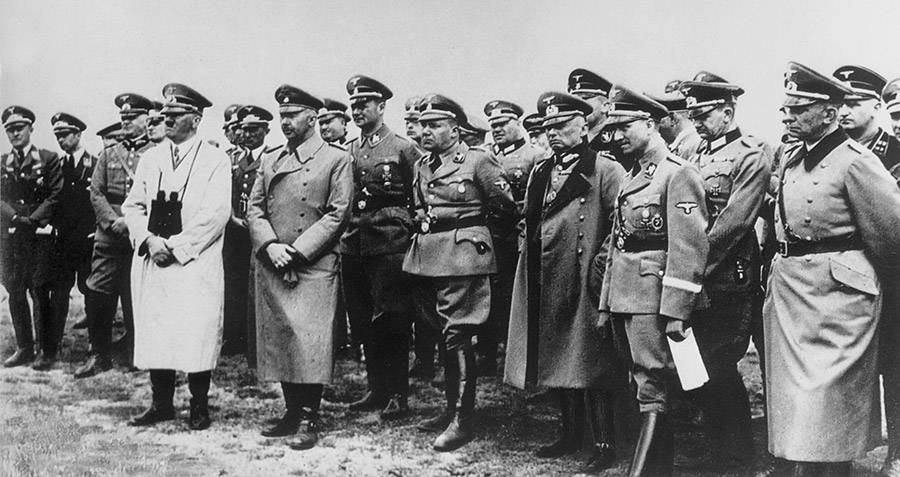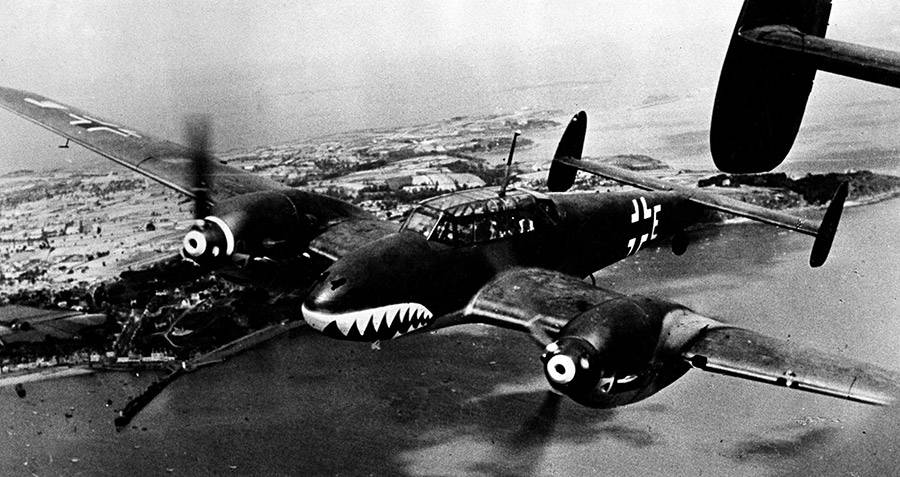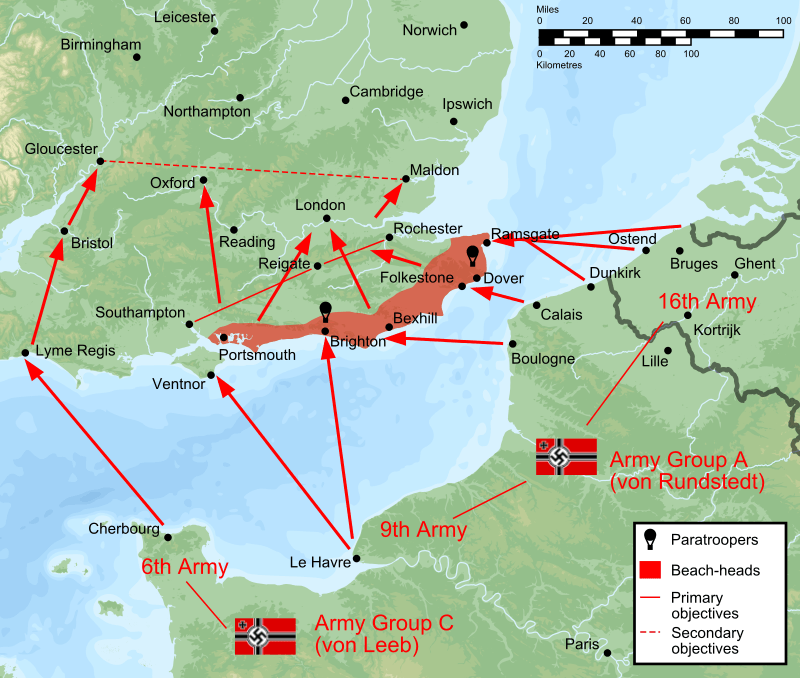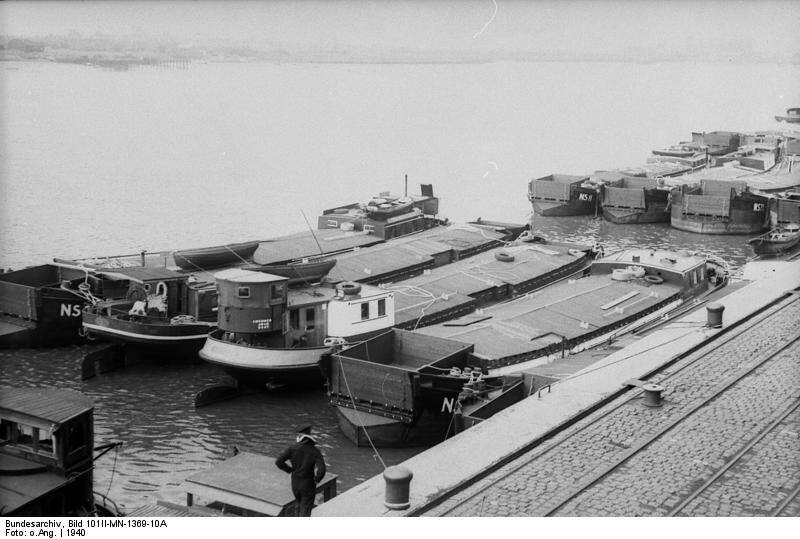While many leaders in Germany were in favor of Operation Sea Lion, Hitler was initially against it. Only when Britain rejected to surrender did he demand prompt escalation.

Hulton Archive/Getty ImagesAdolf Hitler stands with Heinrich Himmler (to his immediate left) and his staff, contemplating the chances of an invasion while looking across the English Channel from Calais during World War II.
Nazi Germany’s desperation to invade Great Britain was explored in a variety of ways during World War II. Some high-ranking members of Germany’s senior military leadership called for landings on British shores. Others pushed for blockades that would cripple the English economy.
The final decision, however, was to engage in a seaborne invasion to capture various ports along the English Channel, and then force Britain to surrender. According to ThoughtCo, the strategy was to commence shortly after the Fall of France in late 1940. It was called, quite aptly, Operation Sea Lion.
Commander of the Kriegsmarine Grand Admiral Erich Raeder and Reichsmarschall Hermann Göring of the Luftwaffe both sternly lobbied against a seaborne invasion. Forcing Britain to endure exhaustive economic hardship through blockades would be a safer, more effective approach, in their minds.
German Army leadership, meanwhile, argued thoroughly for landings in East Anglia, which would’ve had 100,000 soldiers climb ashore. Raeder thought of this as nonsense, as it would take a year to organize the requisite shipping logistics — never mind the absolute imperative of having to neutralize the British Home Fleet before they could be transported across the English Channel.
Göring agreed and explained that such a bold, confident move should only be employed as a “final act of an already victorious war against Britain.” To Adolf Hitler’s surprise, London rejected surrendering to the Nazis even after they had taken over France, which led him to issue Directive No. 16 on July 16, 1940.
“As England, in spite of the hopelessness of her military position, has so far shown herself unwilling to come to any compromise, I have decided to begin to prepare for, and if necessary to carry out, an invasion of England…and if necessary the island will be occupied.”
Thus, Operation Sea Lion was set in motion.
Nazi Germany Begins Planning Operation Sea Lion
With Great Britain declining the Führer’s proposal regarding peace talks, and a variety of burgeoning strategies at his disposal to advance, Hitler agreed to move forward with Operation real Lion under four conditions.
First, the Royal Air Force had to be eliminated, as German military planners had already suggested as a requirement in 1939. Second, the English Channel had to be clear of enemy mines, and strategically littered with German mines. Third, artillery should be placed along the English Channel. Lastly, the Royal Navy had to be stopped from preventing German craft landing ashore.

ullstein bild/ullstein bild/ Getty ImagesGerman fighter planes Me-110 above the British channel during the Battle of Britain.
While Hitler was confident in the strategy, neither Raeder nor Göring were eager to move forward with an invasion. German fleets sustained serious losses during the invasion of Norway, which dissuaded Raeder from agreement. Not to mention that the Kriegsmarine didn’t have enough warships to trounce Britain’s Home Fleet.
Nonetheless, planning moved forward under the leadership of Chief of the General Staff General Fritz Halder. Hitler’s original schedule of invading on Aug. 16, however, had proven unrealistic. He was briefed on that matter during a meeting with planners on July 31, and told that May 1941 would be a viable date.
Ever the stubbornly eager military leader, Hitler rejected the nine-month delay in favor of a one-month alternative. Operation Sea Lion, the invasion of Britain, was set for Sept. 16, 1940. The early stages would see German landings on a 200-mile stretch from Lyme Regis to Ramsgate.

Wikimedia CommonsThe initial plan would see German landings on a 200-mile stretch from Lyme Regis to Ramsgate. The operation was eventually postponed indefinitely.
This plan would also have Field Marshal Wilhelm Ritter von Leeb lead the landing of Army Group C in Lymes Regis, while Field Marshal Gerd von Rundstedt’s Army Group A sailed from Le Havre and Calais to land in the southeast.
Raeder, whose surface fleet still suffered from the losses in Norway, opposed this strategy. With his depleted fleet, he simply wasn’t confident he could defend his men from the Royal Navy. Hitler surprisingly listened to Raeder, and agreed to a narrower scope of the invasion — which Halder felt would lead to more casualties than necessary.
Operation Sea Lion — Change Of Plans
The change in plans moved the date of the operation back to August — even earlier than originally scheduled, to Aug. 13. It also relinquished Army Group C from responsibility, and would have only Rundstedt’s Army Group A participate in the initial landings. The westernmost landings would now be made at Worthing.
Rundstedt would lead the 9th and 16th Armies across the English Channel and create a solidified front from the Thames Estuary to Portsmouth. After building his forces back up, Rundstedt would command a pincer attack against London.
Once that was taken, German troops would march north to the 52nd parallel. Hitler thought Britain would surrender by the time they reached that point.

Wikimedia CommonsInvasion barges at Wilhelmshaven. 2,400 barges from across Europe were collected, but this was still too few — and they could only be used in calm seas. 1940.
Throughout these fluctuating plans, delays, and assumptions, Raeder was dealing with actual, tangible issues. He had no purpose-built landing craft to complete his part of the strategy. The Kriegsmarine collected around 2,400 barges from across the continent, but this was still too few — and they could only be used in calm seas.
While these barges were dispersed across the Channel ports, Raeder’s lack of faith in the plan remained steady. He had no confidence that he’d be able to defend his men against the Royal Navy’s Home Fleet, and as such, protect the rest of Germany’s invading troops from British defense.
In the meantime, the Brits were in heavy defensive preparation. Though much of their heavy equipment was destroyed during the Battle of Dunkirk, the British Army did have a substantial amount of troops available. General Sir Edmund Ironside was chosen as leader of the island’s defense.
His plan was to set up defensive lines around the south, which would be backed by Anti-tank machinery. Those, in turn, would be supported by small bastions of troops.

Wikimedia CommonsWinston Churchill visits bombed out areas of East London. Germany’s Luftwaffe did untold damage even without an invasion. Sept. 8, 1940.
Of course, none of this would come to be, as Germany was embattled in numerous other, time-sensitive operations. Between the lack of preparation, imperfect strategy, and Hitler’s attention toward Russia — the invasion of Britain has remained a mere what-if to this day.
Hitler Cancels Operation Sea Lion
Historians have long debated whether or not Operation Sea Lion could’ve succeeded. The overwhelming consensus seems to be that the Royal Navy would’ve stopped the Kriegsmarine from its landings, as well as its re-supply of troops.
The reason this plan was canceled was largely lack of preparation, and failure to establish the conditions necessary to succeed. British Spitfires and Hurricanes dominated the skies over southern Britain, and without control of the skies — sneaking thousands of German troops onto shore seemed a fool’s errand.
When the Luftwaffe failed to defeat Air Chief Marshal Hugh Dowding’s Fight Command during an air raid on Sept. 15, Hitler summoned both him and Rundstedt on Sept. 17 and postponed the operation. When his attention turned to the Russians, and planning of Operation Barbarossa began, Hitler never looked back.
After reading about the Operation Sea Lion, the Nazi plan to invade Great Britain, learn how the Nazis rose to power. Then, read about how drugs like Pervitin and cocaine fueled the Nazis’ rise to power.





